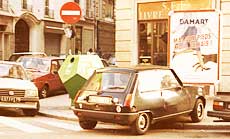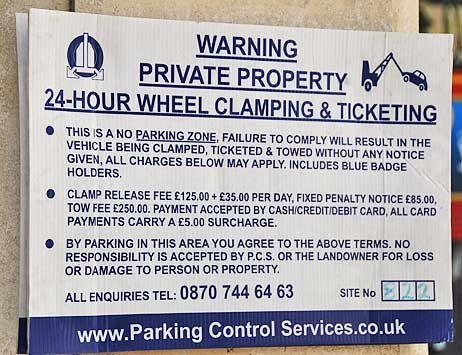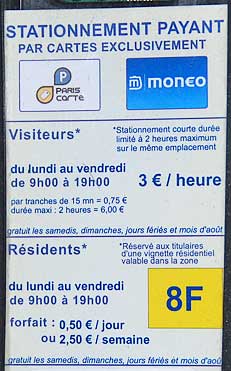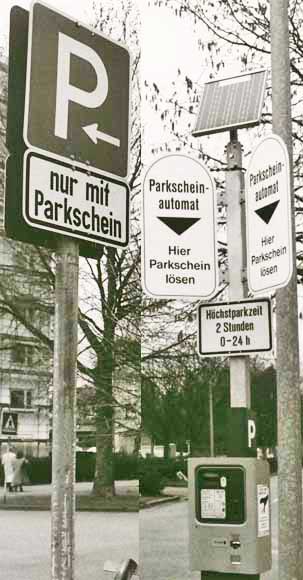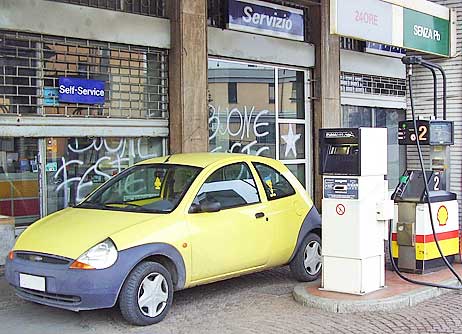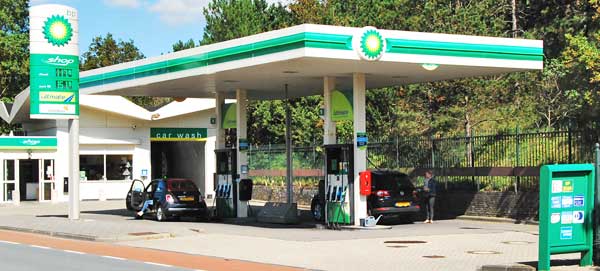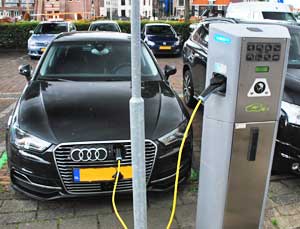Parking, Gasoline, Safety
Adjuncts to Driving a Car in Europe
No parking, the clamp, octane, insurance, vandalism, safety, fog lights, compass, GPS, electric cars.
The Amsterdam police have a special vehicle full of clamps. We call them the Denver boot in the USA. The officers cruise the streets and canals looking for parking violators, ticket them, and promptly clamp them. Parking on many streets in Amsterdam is reserved for locals with a permit. If you ever find an empty parking space in Amsterdam read all the signs, if you can read Dutch. Clamping is a very high profit business for police departments throughout Europe. There goes your seven course gourmet dinner. Think about it.
Carpe diem. Vivere bene! Gratia Deo.
Chapter 18 part 4 of
HOW TO EUROPE:
The Complete Travelers Handbook
John Bermont
This entire book is published totally free on-line by the author, photographer, and webmaster, yours truly, with help from my daughter Stephanie. I welcome all questions, comments, compliments, and complaints. For contact information please see NOTE TO READERS. Updated 27 November 2015.
There are more cars than parking places.
IN FOUR PARTS
This Internet edition of chapter 18 is divided into four parts because it is so big. The four parts are:
- European Auto Rental: Details and Documentation .
- Driving in Europe: Back Alley to Blazing Autobahn.
- Laws and Habits: Police, Speed Limits, Tailgaters.
- Parking, Gasoline, Safety: Adjuncts to Driving.
PARKING
Finding a legal cheap or safe place to park your car is a major challenge, especially in the big cities. Make sure that your hotel has inside parking. Of course they charge. At that type of hotel the cost of parking overnight will probably be as much as I spend for a room in my class of hotel.
On my first drive to Paris I found PLENTY of parking places — right on the Champs-Élysées, the grandest boulevard in the city. In the morning the sanitation crew worked around my little Porsche and I got it out of there before the tow truck was called.
Here is an alternative parking method as practiced in Paris. Notice the green container in the background. That is for recycling green glass, e.g. wine bottles. Cities throughout Europe have similar containers to encourage recycling. There is another Do Not Enter sign. They are everywhere.
No Parking
The NO PARKING sign is a blue circular board with a diagonal red band across it. NO STOPPING is a blue circle with two perpendicular diagonal red bands across it — a big red X if you will. Both also have a red border. NO PARKING signs may also be found in the local language posted on gates and garage doors, whether there is a sloped drive at the curb or not. If you see a word like interdit, prohibida, or verboten, think about it before you walk away from your car.
Another indication that you are not allowed to park is a large X in the parking place. This is two diagonal lines from corner to corner.
Parking within reach of a No Stopping sign is a favorite European pastime. This Mercedes in Riga, Latvia has a souvenir on his windshield.
You probably don't need to know German to understand what this sign means. Hint: if you park your car in this place in Vienna, Austria it will not be there when you return.
Europeans normally park anyplace they can fit their car. Sidewalks and the middle of streets are used. Cars are often ticketed, but usually not towed unless they are blocking traffic. With American license plates, police would often put a kind notice on my car rather than a ticket. In one case when I went to the Haarlem police station to pay a parking ticket, the official looked at the ticket, looked at me, and asked, "Are you American?" I answered, "Yes." He replied, "American no pay!" and tore up the ticket. However, after having been ticketed a couple of times for parking on the sidewalk in front of my house, the police angrily announced that they would tow my car away the next time. There was no next time.
The German police can be downright nasty. I stood by my doubleparked car waiting for Elizabeth to run into the post office and drop off some letters. An officer walked over and told me to move it. I did, but I got a violation notice in the mail a week later anyway.
The Clamp
The Denver boot is known as the clamp throughout Europe and the process of applying it is called clamping. The Dutch police, unhappy that some German drivers ignore parking meters and violation notices, usually clamp German licensed cars in addition to the ticket. This is an expensive thing to get removed. My car was clamped in Bratislava, Slovakia. Late at night I had inadvertently parked in the space reserved for the Chief of Police, right at the front door of the police station of all places. I discovered the clamp the next morning and asked the hotel to call the police. It would have been a very expensive ticket, equivalent to a few hundred dollars. While the police were removing the clamp, I talked them down to half price, and then kept negotiating and got it down to zero. Our common language was German and it sure paid off for me that day.
This warning sign in London, England should be enough to suggest that you park somewhere else.
Pay Parking
Metered parking is available on many streets and parking lots in Europe. In Paris, a sign in French announces that you must pay to park on the street. The sign points to an automat where you buy a ticket which you place on your dashboard. Many European cities and parking lots use a similar system. If you don't see parking meters look for an automat somewhere on the lot. Many of these have a photovoltaic panel on top. The panel generates the electricity for the machine.
Here are the instructions for using a parking automat machine in Paris, France. Visitors pay €3 per hour and can only stay for two hours. Residents of zone 8F pay only €0.50 per day. I'd rather spend my money on a beer than parking. It is free for everybody on weekends, holidays, and the month of August. Ah ha, I can park AND have my beer!
This sign indicates parking structures in downtown Düsseldorf, Germany with the number of available places in each. The Altstadt, 'Old Town,' of Düsseldorf has some of the liveliest night life in Europe.
Parking structures are becoming common. Look for a rectangular blue sign showing a large white P with a roof over it. In parking structures you often pay at a cashier or automat before going back into the garage to get your car. Then insert the validated card in the exit gate machine while driving out.
Free Parking
In the US, the 'blue zone' is reserved for handicapped persons. In Europe the 'blue zone' is totally different. It allows limited time free parking on the honor system, for everyone. Zone Blue parking means that you must place a blue card on your dash board and set the pseudo clock face to the time that you arrived. You can then park for free for the time allowed as stated on the street sign. Buy it in a stationary store and use the Blue Zone card in France, Germany, and other countries. Some businesses give them out for free.
When traveling by car, it pays to use the Michelin Red Guides to find hotels and for other travel services. These guides show which city hotels have a garage or off-street parking. Very few do, and those which have it often charge extra. Hotels with garages rarely have enough parking spaces for all the guests. Claim a space early so you don't have to park out on the street. Most of the motels along the highways have free parking and plenty of it.
Bumpered Cars
Finally, in discussing parking, the Paris method comes to mind. It explains the derivation of the word 'bumper,' as on the front and rear of your car. In the tight parking spaces on the streets of Paris, this method tends to create a larger parking space and helps to minimize the work of turning, backing, and going forward again. Just back in until you hit the car behind you. Then turn in, drive forward and smack the one ahead of you. Turn out, and quickly rip into the car behind you again. Straighten out and inch it forward. If you're going to live in Paris, I recommend a six-year-old never-washed Peugeot. The Paris method is also practiced in Amsterdam, with gusto.
The large P indicates a parking lot in Aschaffenburg, Germany. The instructions are all written in German so here is a translation. The "nur mit Parkschein" means "only with parking voucher." Nearby you see the sign "Parksheinautomat" which indicates the "voucher machine" and "Hier Parkschein lösen" which means "buy parking voucher here." "Höchstparkzeit 2 Stunden, 0-24 h" means that the "maximum parking time is 2 hours, and the lot is open 24 hours a day." You see the voucher machine under the lower P, powered by the solar electricity collecting panel at the top of the pole. Normally these machines take only coins though some may accept "chip+pin" European bank cards.
Place the voucher on your dashboard with the date and time legible from outside. Lock your doors. You will be ticketed, and maybe worse, if you don't pay or if you overstay the amount of time for which you paid. Germans are very law abiding and the cops are really strict.
GASOLINE
Tanking up starts with knowing where the gas cap is located on your car, and knowing how to open it. These rudimentary minor items are not standardized in our modern world. To save yourself some potential embarrassment and frustration ask the auto rental company before you drive off.
Also be clear on their gasoline policy, i.e., how much, if any, should be in the tank when you return the car, and how much will it cost you if it is below that level. They may charge you the maximum local price plus a commission plus a service fee to go get the gas.
Cost
Gasoline costs much more than it does at home, throughout Europe.
Here is the price of gasoline and diesel at a BP station in Haarlem, Nederland in September 2015. That might look like a really good deal, only 1.519. But that is euros per liter. At that time it cost me $1.13 per euro at an ATM machine and there has always been 3.785 liters in a gallon. After doing the math the price works out to $6.51 per gallon. At that time the AAA reported in a press release that the average price for regular gas in the USA was $2.39 per gallon, with some states coming in under $2.00 per gallon. So there you have it, gas costs about three times as much in Europe as at home. This is one of the reasons that most European cars have always tended to be of the itsy bitsy sort.
No Gas
They don't call it gas in Europe. It can be called petrol, benzine, benzin, essence, or some other name. Diesel can go by diesel, gasoil, nafta, or some other name.
No Gallons
You can't buy a gallon of gas in Europe. Gas is sold by the liter, spelled litre in some countries. Our gallon is equal to a tad less than four liters. To be more exact, it is 3.785 liters per gallon. See more about the metric system in chapter 27 Metric System in Europe: Travel with Grams, Meters, Liters, and Celsius.
Octane
Both high and low octane are sold. The octane ratings in Europe are slightly less than in America. Although my Porsche ran fine on regular in the USA, I had to use super (the common name for "high octane") in Europe. I used super in my 1.9 liter Opel in Germany also. Just because the gas cap states the minimum octane doesn't mean that you have to use it. I generally use the highest octane to get some extra power out of the engine. This is very useful in passing slower vehicles on some of those winding roads.
Unleaded
Unleaded gas is sold almost everywhere. The German word bleifrei, (lead free) is often used in the east. French for unleaded is sans plomb (without lead). You don't see this spelled out much anymore because virtually all gasoline is lead free.
Service
Many stations are self-serve. Pump your own and go inside to pay. It is becoming more common to be able to insert your credit card at the pump so you don't need to go inside. Some stations allow this even if they are closed. But don't count on being able to use a credit card everywhere for gasoline. Some stations are cash only. Never travel without a few days supply of local cash in your pocket.
Gas stations provide free air and water, and have all the usual items for sale. Maps are expensive. Restrooms are free and are generally cleaner than in America. You can buy booze at gas stations in Britain where you see the "off license" sign.
This 24 hour gas station near Monza, Italy is closed on Sunday, but it is open if you have the right plastic. You probably don't have the right plastic unless you have a European bank account. See chapter 8, ATMs in Europe: Cash and Credit for Travel. Self serve stations like this are common throughout Italy. Senza Pb means unleaded.
The BP gas staton in Haarlem allows you to pump your own. The roster of credit cards is posted on the entry sign. Maybe yours will be accepted. Maybe not. There is a handy car wash and a mini shop for daily needs included. Stations in Holland are mighty tidy.
Open Hours
A good rule to follow is keep your tank at least half full, especially on Sunday nights. As with most restaurants and shops, gasoline stations are often family businesses. The general practice is that stations in towns have open hours similar to the hours of other businesses. Europe never was like America with a gas station (or two or three) on every corner open until midnight. However, there are a growing number of 24 hour stations, attended and unattended. The 24 hour stations usually have basic provisions like the USA's '7-Eleven' stores.
ELECTRICITY
So you have one of those new fangled electric cars, eh? There is no problem "tanking up" in Holland. You'll see charging stations in just about every public parking lot and even on city streets in residential neighborhoods.
MAINTENANCE
Dealers and a large number of independent garages service automobiles. Quality of service ranges as widely as it does at home. The biggest difference is cost and how long it will take to get parts and make repairs. My experience in Holland is that it can take months to get simple items from Germany if the dealer does not stock the part.
I drove over to Stuttgart to get the Porsche tuned up at the factory, sort of an aside to a vacation trip to the south of France. I left the car at the factory for two days and enjoyed the tail end of a wine festival and some nice sightseeing while they worked on the motor. Apparently the mechanics had a little too much wine festival themselves because 70 miles south of Stuttgart the engine went dead in a small Dorf. Neither of the garages in the town knew what to do so I had to take a room overnight and call the factory the next morning to get help. After getting the supervisor on the line, I handed the phone to a mechanic, he said "Ja, ja, ja," hung up, took a screwdriver over to the car, adjusted something, and I was on my way. About a year later, shortly after I returned to the USA, the timing chain went kaput and the engine blew up, costing some $4,000 for repairs. So much for German quality.
For my German Opel, my company had leased the car and took care of all maintenance expense. I would just drop it off and the dealer drove me to the office. Pretty simple. However, you just about have to know some German to get special items taken care of. Auto mechanics only speak the native tongue.
Windshields
One surprisingly weak point in older and cheaper European cars is the windshield. Simple tempered glass had been used in some vehicles. In years past I have seen quite a few autos stopped by the side of the road with the windshield shattered and glass chips all over the passengers. If you are buying an older used car in Europe as an antique, make sure that it has the sandwich-style windshield (safety glass) which does not shatter. Look for D.O.T. on the glass and read the US Customs brochure on importing a car.
INSURANCE
If you buy a car in Europe or ship your own car over you are going to need insurance. Only a fool would drive in Europe without insurance, and only a clever fool could get away without it for any length of time. Your home state auto insurance does not cover you. You must purchase insurance valid in Europe.
Two Plans
There are two basic types of insurance. The "all-risk" insurance, identified by the green card, protects you against everything. It is required before crossing borders in Europe. The other plan is a limited protection insurance available to residents of each country valid in that country only. But if you have an accident outside that country, expect to be held by the police until you settle up for the damage you caused.
I bought my own insurance when living in Holland. In Germany, my employer provided it. However, they were initially going to provide only the basic service until I requested them to change this to "all risk" insurance. I was driving all over Europe.
Cost
Insurance is very expensive, upwards of double the rates in a large American city. Substantial discounts are available. Your company may be in a group policy arrangement allowing up to a 30% discount. Furthermore, with a good driving record and no claims on your policy at home, you may be eligible for up to 30% off the balance. Bring a copy of your policy, an affidavit from your agent, and a state motor vehicle report of your good driving record as evidence. Thus, it is possible to be insured for about half the going rate.
Where to Buy Insurance
Auto insurance is sold by banks and directly through European insurance companies. If you are purchasing an auto for tourist pick up, insurance is an obligatory part of the deal. You will not be allowed to pick up a car at a dealer or at the port unless you have a green card with you.
CRIMINAL ACTS
Theft and Vandalism
Theft and vandalism against automobiles is a common problem in Europe. The large cities are the worst for it, but it can happen anywhere. In Haarlem, a medium sized city in Holland, my car suffered a stolen antenna, stolen side view mirror, and attempts to pry off the California license plate and the Porsche emblem in various attacks by vandals. In Aschaffenburg, a smaller city in Germany, my antenna was ripped off along with all the others on our street. One night I caught a weirdo trying to get into the car. It's nice to have a garage.
A senseless vandal must have enjoyed defacing the door of this car in Paris, France. [Photo by Stephanie.]
Defenses
Do not leave anything visible in your car. Do not park it on a dark side street overnight. The vermin hang out in the shadows. Park it on a busy street under a street light. When I drove to Paris the first time I parked on the Champs-Élysée, a couple blocks from the Arc de Triomphe. Don't even leave anything in the trunk. Chances are that other keys fit your trunk. An out-of-country license plate indicates a traveler and tells a thief that there are probably goodies inside. Take everything to your hotel room and leave the thief disappointed.
I used two devices in the car when we made our trip from Germany to and from Istanbul. One was a lock bar connecting the brake pedal to the steering wheel. If someone were to break in and hot wire the engine they would have a nearly impossible job of driving anywhere but in a straight line. The other device was a fake burglar alarm. It was just a little black box with a blinking red LED light that I put into a slot on the dash. It made it look like the car had a burglar alarm at night.
For my Porsche I had the real thing, a full blown howler alarm that was activated by any movement of the car. That could be another car attempting to parallel park in front or in back which nudged mine. Earthquakes in California set it off a couple of times, as did a tow truck which hauled it away once. Then there was the day in Haarlem when some drunken Danes from a tour boat tried to roll my Porsche into the Spaarne River. They could have done it if I hadn't raced across the street to stop them. I warned the captain of the tour boat that I would sink his ship if that ever happened again.
SAFETY AND OTHER ISSUES
Seat Belts
Use of seat belts is required everywhere.
Emergency Kit
The AAA recommends that drivers carry an emergency kit in the trunk. This should include water, non-perishable food items, jumper cables, a strong beam flashlight with extra batteries, road flares ar an emergency beacon, basic hand tools, and a first aid kit.
Europeans typically enhance this list with a red reflecting triangle, towing cable, and a fire extinguisher. These items are required by law in some countries. Spare bulbs for headlights and turn signals may also be required, though I would hope they are easier to change than on American cars. In the USA you almost have to pay a mechanic $60 to change a one dollar light bulb. When you rent a car ask about these items and if they are on board.
France has enacted a new law aimed at reducing alcohol road kill. Every car must carry a breathalyzer. The French tradition of wine at lunch and dinner had contributed to its very poor record in driving safety. Hopefully that will soon be history. I have also read that there must be a day-glow safety vest for every passenger. Violations cost over $100. Ouch!
Tires
Check your tire pressure regularly. Under inflated tires can cost you dearly in wasted fuel, a precious commodity in Europe. If you don't have a gauge at least do a walk around and a visual check of each tire. Low air is usually obvious. When I drove through the east to Istanbul I carried a 12 volt air pump for the tires. It plugged into the cigarette lighter outlet and came in handy. Several drivers at border crossings wanted to buy it from me when they saw me topping off my tires.
Fog Light Features
Many European cars are equipped with a rear fog light. There is a switch on the dash for this. You'll probably have to look in the owners manual to locate the switch. The fog light is a single bright red light on the left rear. It can be seen from a much greater distance than the normal rear lights. It is also a good idea to use this when there is a light rain because the wheels of your car turn up so much mist that it is hard to see through it. This light cuts through a lot of mist. Another car can give your rear end a bump if you're going too slow and road conditions are poor.
Another auto light feature you might find is a roll switch which will raise or lower the aim of the headlights. Keep the lights pointed down in the city and raise them for country driving. This switch is not the high beam switch. That one turns on the brights, as you know, something that you should rarely do.
Compass
As noted above, compass directions are not posted at intersections. For example, in the USA you always see route numbers and "north" or "south" etc., right under the route number sign. You will never see this in Europe. Heck, even route number signs are relatively scarce in Europe. I should never say never since compass directions will eventually be posted, probably. But you know that they will be in the local language. Do you know est from ouest?
Therefore it is a very good idea to have a car compass. The better quality ones have adjustment screws to let you compensate for the metal in the car. All that magnetically inclined steel can affect the operation of a compass considerably. Get one with a night light and mount it on your dash.
Global Positioning System, GPS
The modern day equivalent of a compass is a GPS device. Actually, it is far more powerful than a compass. It tells you exactly where you are and plots your course for you. Officially named Navstar GPS, the main feature is a system of about 30 satelites owned by the US Department of Defense. They broadcast signals which can be picked up by electronic devices which most people just call a GPS. These devices use triangulation and super accurate clocks to determine where on earth the device is and where it is going. Assuming you are holding the device you will never be lost again. That sure takes some of the fun out of life.
Then again a GPS can be fun. On a flight from Minneapolis to Santa Ana the fellow next to me turned on his GPS. It was interesting to track our progress and to know what it was we were flying over.
When renting a car in Europe many people will not drive out of the parking lot without a GPS in their hand. I have never used one but I can assure you that I wish that I had one of these genies on some of my drives. I can read maps and follow signs but Europe is not where those talents are appreciated. If you are out in the boonies you often need a local guide to show you which road to get on and in which direction. A GPS is the closest substitute for a local guide. But neither is foolproof. A map and compass is a recommended back-up combo.
These signs in Nova Milanese, Italy point you in the direction of a half dozen villages and cities, the village center, the shopping center co-op, and a couple of motels. No route numbers are given but distance is shown, in kilometers. See chapter 27 Metric System in Europe for information on that.
DRIVE ON
As noted above, this Internet edition of chapter 18 is divided into four parts because it is so big. The four parts are:
- European Auto Rental: Details and Documentation .
- Driving in Europe: Back Alley to Blazing Autobahn.
- Laws and Habits: Police, Speed Limits, Tailgaters.
- Parking, Gasoline, Safety: Adjuncts to Driving.
Have a good trip!
NOTE TO READERS
I welcome questions and comments. If you have any concerns about your trip to Europe that have not been covered well enough in this section please do not hesitate to write and ask. When you write please include relevant details, per the folowing paragraphs.
I do not open attachments. I do not click links to web pages of any kind. I will reply in a day or two, usually.
Do not forget to smell the hyacinths. At your liesure scroll through the Table of Contents of How To Europe: The Complete Travelers Handbook and read all 30 chapters, FREE on line. Good deal! You'll probably find the answers you seek, and some you didn't know you needed.
My email address is johnbermont@enjoy-europe.com.
FREE
This web site is totally free for everyone, and a labor of love for me. To keep it afloat I receive a commission from Amazon.com for all goods purchased through the adverts I have selected, and any other products you might buy when you are on the Amazon site. Amazon has almost everything for sale, except the Brooklyn Bridge and Mount Rushmore.
Please visit my on-line store at
 .
Your support is most gratefuly appreciated. TIA.
.
Your support is most gratefuly appreciated. TIA.
To like and like not:


Adverts
To support this site:
Please buy your goods at:Amazon.com
Shop in your shorts!
Please clean out your cookie jar before clicking.
The details on driving in Europe may save your life.
 Driving in Europe 101by Curley Bowman
Driving in Europe 101by Curley Bowman
Michelin will get you on the right road.
 Europe Map Michelin
Europe Map Michelin
The best travel guide to all of Europe.
 Europe on a Shoestring
Europe on a ShoestringLonely Planet
A comprehensive guide to 3,000 hotels and restaurants in 44 major cities throughout Europe, in English. Separate books in the Michelin Red series cover individual countries in greater detail. This is a must have for frequent travelers.
 Main Cities of Europe 2015
Main Cities of Europe 2015Michelin Guide
The Marling Menu Master series is the best for interpreting restaurant offerings in France, Germany, Spain, and Italy.
 Marling Menu Master
Marling Menu MasterFrance
The links in this pink field take you directly to a page at Amazon.com. The Amazon page details the item, and in most cases includes candid and critical comments from others who have bought the item.
Amazon pays my site a small commission when you click and order an item, if you put it in your shopping cart within 24 hours based on the cookie they set on your computer. If you don't want to make a quick decision just put it in your shopping cart, think it over, and come back later. The revenue covers the cost of maintaing this web site and keeps it free to users.
You benefit when buying here because Amazon has:
- 20% - 30% discount on many items,
- free shipping deals, direct to your door,
- no sales tax on internet purchases in most states,
- zillions of products, well almost,
- fast delivery even when it is free,
- shipment tracking in UPS, USPS, FedEx,
- easy returns if you are not happy with the product.
You win we win. Thanks for your support!!
Have a good trip in life,
John Bermont
Note: Italicized notations by the author.
If your gizmos charge through a USB port this can keep you going. European cars have the same 12 volt electrical system as American cars.
 Scosche Dual USB
Scosche Dual USBCar Charger
Rolling luggage sure beats lugging a pack on your back.
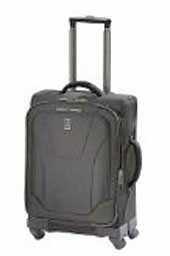 Travelpro Luggage Maxlite 2 20" Expandable Spinner
Travelpro Luggage Maxlite 2 20" Expandable Spinner
A shoulder bag for your daily walk-about.
 Travelpro Luggage Maxlite3 Soft Tote
Travelpro Luggage Maxlite3 Soft Tote
Keep your stuff organized. There are more than a dozen colors and patterns to choose from.

Luggage Packing Cubes
eBags 3pc Set
The two gallon size is excellent for packing your clothes, but it is hard to find in Europe.
 Two gallon plastic bags
Two gallon plastic bagsZipLoc by SC Johnson
Inconspicuously lock your zippered luggage with a black wire tie.
 Cables to Go 43036 Cable Ties - 100 Pack (Black)
Cables to Go 43036 Cable Ties - 100 Pack (Black)
Plug adapters are needed throughout Europe. There are at least five models used in different countries.
Note: The highlighted #E number is purely arbitrary. It is meant to help quickly identify products in this advert column when you write in for electrical advice.
See NOTE TO READERS.
This adapter is for the standard grounded plug in France, Germany, and northern Europe. It does not fit in outlets of Italy, Switzerland, Ireland, and Britain.
#E-010
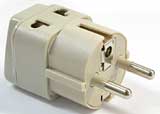 Grounded Universal 2 in 1 Plug Adapter
Grounded Universal 2 in 1 Plug Adapter
European Schuko plug.
4.8 mm prongs.
Equivalent to type E and F.
You can use this ungrounded Euro plug in some European countries.
#E-020
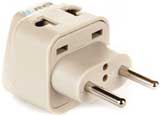 Universal 2 in 1 Plug Adapter
Universal 2 in 1 Plug Adapter
Euro Plug
4.0 mm prongs.
Equivalent to type C.
This is a universal plug adapter for the UK and Ireland.
#E-030
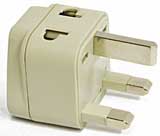 AC Adapter Plug for use in England, Scotland, Wales, and Ireland
AC Adapter Plug for use in England, Scotland, Wales, and Ireland
Equivalent to type G.
Here is the Swiss version.
#E-040
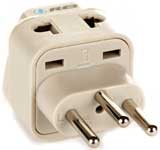 Grounded Universal 2 in 1 Plug Adapter
Grounded Universal 2 in 1 Plug Adapter
Type J for Switzerland
Here is the grounded Italian model.
#E-050
 Grounded Universal 2 in 1 Plug Adapter
Grounded Universal 2 in 1 Plug Adapter
Type L for Italy
This 110-250 volt power surge strip has three universal outlets and an American grounded plug so it needs a plug adapter for the countries you are visiting. Make sure your gizmos are rated for 110-240 volts.
#E-060
 SM-60 Universal 3 Outlet Power Strip Surge Protector for Worldwide Travel. 110V-250V with Overload Protection.
SM-60 Universal 3 Outlet Power Strip Surge Protector for Worldwide Travel. 110V-250V with Overload Protection.
If your gizmos charge through a USB port this can keep you going. European cars have the same 12 volt system as American cars.
#E-200
 Scosche Dual USB
Scosche Dual USBCar Charger
For small appliances travelers may find these true transformers useful. They deliver the full sine wave. Caution: The wattage rating is the max short term. For continuous duty I recommend that you select a transformer rated at two times the combined watts of all gizmos plugged it. But check your gizmo's electrical specification plate before buying one of these. Most electronic devices are dual voltage and can be plugged in any European outlet when using the appropriate plug adapter.
This 50 watt 220/110 volt step down transformer is good for very small 110 volt appliances and light duty chargers.
#E-070
 Travel Smart by Conair 50-Watt International Transformer
Travel Smart by Conair 50-Watt International Transformer
Absolutely the best battery for digital cameras which use AA batteries.
#E-120
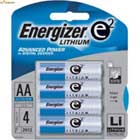 Energizer
EnergizerAA Lithium Batteries
4 Pack
Make sure that your electrical appliances are 110-220 dual voltage so they will work in Europe.
Note:
These appliances require a plug adapter, NOT a converter, for the countries you are visiting. See plug adapters above.
#E-130
 Vagabond Compact Styler
Vagabond Compact StylerConair's Dual-Voltage Ionic Hair Dryer
 Anne Klein Women's Classic Double-Breasted Coat
Anne Klein Women's Classic Double-Breasted Coat
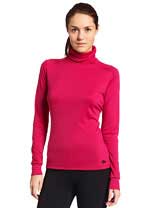 Hot Chillys Women's Peach Skins Solid T-Neck Shirt
Hot Chillys Women's Peach Skins Solid T-Neck Shirt
Wear a scarf for comfort and style. Nobody will ever suspect that you are an American.
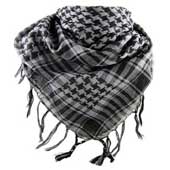 Very soft houndstooth neck scarf. Various colors available
Very soft houndstooth neck scarf. Various colors available
Be ready for the rain.
 Happy Rainy Days
Happy Rainy Days
Women's Jacket
This will come in very handy very often.
 Fenix LD15
Fenix LD15High Performance
LED Flashlight
A Swiss Army Knife is unquestionably the handiest item a traveler can carry, except not on a plane.
 Victorinox Swiss Army Huntsman II Knife
Victorinox Swiss Army Huntsman II Knife
To help find your way on the winding and poorly posted roads of Europe. It works for civilian travelers also.
 Lensatic Military Marching Compass
Lensatic Military Marching Compass
One of my favorite books. Ernest Hemingway in Paris.
 A Moveable Feast
by Ernest Hemingway
A Moveable Feast
by Ernest Hemingway
The details on driving in Europe may save your life.
 Driving in Europe 101by Curley Bowman
Driving in Europe 101by Curley Bowman
Michelin will get you on the right road.
 Europe Map Michelin
Europe Map Michelin
The details on driving in Europe may save your life.
 Driving in Europe 101by Curley Bowman
Driving in Europe 101by Curley Bowman
Michelin will get you on the right road.
 Europe Map Michelin
Europe Map Michelin
The best travel guide to all of Europe.
 Europe on a Shoestring
Europe on a ShoestringLonely Planet




